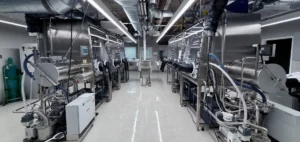EDF is preparing for a crucial milestone in the development of its EPR (European Pressurized Reactor) in Flamanville, with the imminent initiation of the first nuclear chain reaction. The project, which has taken 17 years to complete and has encountered numerous delays and technical challenges, is part of a strategy to renew and strengthen France’s nuclear fleet, with the aim of guaranteeing reliable, low-carbon power generation.
Background and Challenges of the Flamanville 3 Project
The Flamanville 3 project, which began in 2007, has been plagued by technical difficulties and significant cost overruns, pushing back the commissioning date originally scheduled for 2012 several times. This new-generation reactor, designed to deliver 1,600 MW of power, will become the most powerful in France, capable of supplying 3 million homes. The complexity of the project reflects the challenges inherent in building new nuclear infrastructure, but alsoEDF ‘s ambition to master cutting-edge technologies in terms of safety and energy efficiency.
Pre-commissioning tests have recently reached a critical phase. EDF has completed the cold tests and begun the hot tests, simulating the reactor’s operating conditions at 155 bar and 303 degrees Celsius. Flamanville 3 operations manager Grégory Heinfling explains that the aim now is to achieve the first nuclear fission chain reaction in the next few days or weeks, subject to final approval by the French nuclear safety authority (ASN).
Technology and Safety: EPR Innovations
The Flamanville EPR is distinguished by major technological innovations, including a fully digitized control room and an enhanced safety design. The control teams, trained to operate the reactor using a simulator that faithfully reproduces the control room, are ready to initiate the divergence process. François Tronet, a trainer at Flamanville, explains that this operation involves progressively raising the control clusters to control the nuclear reaction, a precise process in which every movement is monitored by sensitive sensors.
The success of this first chain reaction will pave the way for the production of the first megawatts of electricity, scheduled for late summer. The reactor will reach 25% power before being connected to the grid, enabling the massive Arabelle turbine to start generating electricity. The ultimate aim is to reach full production capacity by the end of the year, reinforcing nuclear power’s contribution to France’s energy transition.
Perspectives and Impact of the EPR Project
The commissioning of the Flamanville EPR represents much more than just a technical milestone; it symbolizes a renaissance for the French nuclear industry. This project highlights the commitment of EDF and France to maintaining and developing their nuclear expertise, which is essential to meeting the energy and environmental challenges of the 21st century.
The Flamanville reactor, with its ability to supply clean, continuous energy, is part of our strategy to diversify energy sources and reduce CO2 emissions. The project also has a significant economic impact, creating jobs and stimulating technological innovation in the energy sector.
This success could also pave the way for similar projects in France and abroad, positioning the EPR as a viable solution for countries seeking to diversify their energy sources while meeting safety and efficiency requirements.
The upcoming commissioning of the Flamanville EPR marks a significant step forward for the French nuclear industry. Despite its challenges, this project demonstrates EDF’s ability to innovate and overcome technical obstacles to offer a sustainable energy solution. The Flamanville reactor symbolizes not only a technical milestone, but also a strong commitment to a secure, low-carbon energy future.






















